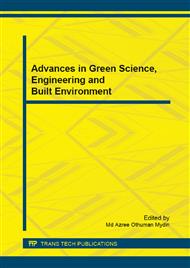p.48
p.52
p.56
p.60
p.64
p.68
p.72
p.76
p.80
Changing Transportation System in University Campus by Cycling and its Impact on Socio-Cultural Characteristics
Abstract:
In Malaysia, universities’ public transportation is less than ideal. This discourages its vast public acceptance and use, particularly in the favor of using private vehicles. That in turn shows its adverse effects, such as traffic jams, environmental pollution, etc. Universities are respected institutions, and pace-setters, in the position to alter and improve the "intellectual culture" in any society. A college campus is open to the public, and its scrutiny. The way public transportation is managed in the campus, could serve as a model for the whole community in large. If we establish an efficient streamlined public transportation system on campus, well received by the faculty, student body and personnel, it would not be long before it is noted by the whole community. A college campus in a sense is public, and belongs to all. Moreover, University Putra Malaysia (UPM) is a leading institution among the other Malaysian universities, notable for its sustainable physical layout. From the research, interview and discuss had been done regarding the effectiveness of power position and municipal authorities. It includes the input from a questionnaire filled by 100 students of UPM University, regarding improvement of public transportation and green transportation systems. This research also addresses a variety of transportation systems -especially cycling- and their conduciveness to social interaction on campus. In this study, we will have the provisions to incorporate our suggested solutions to campus transportation system, into the overall layout of campus planners and university organizers. Ideas and recommendations for solutions would be considered at the end of the study. The ideas and improvements should be well publicized, to promote the public awareness, and its acceptance. In time, it would be engrained as a cultural improvement. Without acceptance, any change would be of little use. Key words: Socio-culture characteristics, in campus transportation, social interactions.
Info:
Periodical:
Pages:
64-67
Citation:
Online since:
March 2015
Authors:
Price:
Сopyright:
© 2015 Trans Tech Publications Ltd. All Rights Reserved
Share:
Citation:


